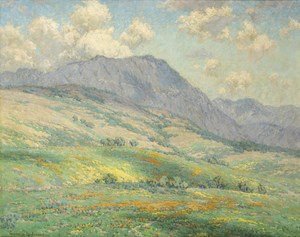
Granville Redmond was stricken with scarlet fever when he was two years old. He lost his hearing, but was fortunate to maintain his eyesight. It has often been suggested that Redmond's hearing loss gave his paintings a particularly quiet and peaceful effect.
From 1910 to 1917, Granville Redmond lived and painted in a variety of Northern California locations. It was some time during this period that Redmond turned to painting his renowned, highly colorful wildflower compositions. There were undoubtedly wildflowers galore in the spring months throughout the California countryside and Redmond must have found it difficult not to incorporate these bright colors into his landscapes. As with many of the painters of the day, Redmond's style was influenced by the French and East Coast Impressionists. West Coast critics noted his use of Pointillism and likened his art to that of Claude Monet and Camille Pissarro.
By the 1920s the promotion of California as a tourist destination was in full swing. Advertisers used images of bountiful orange groves and fields of wildflowers to show off the beauty of the sunshine state and encourage visitors. Redmond's paintings were used as part of this promotion and soon his works were recognized across the country. Interest by dealers in his wildflower paintings rose quickly and the artist found it difficult to keep up with the demand.
In 1917 Redmond moved back to Southern California, in part to try out his pantomime skills in Hollywood. He became friends with Charlie Chaplin and even assisted him in training for The Little Tramp. Redmond had a studio on Chaplin's lot and appeared in some of his films, most notably as the white-haired sculptor in City Lights.
Redmond also maintained a studio in rustic Topanga Canyon around this time, and in the last decades of his life, his sunny scenes of Southern California remained popular with collectors as Impressionism remained in vogue in California long after it had been displaced by other styles elsewhere.
Hazy Day in the Antelope Valley depicts a scene from the western Mojave Desert. Each spring this high desert environment comes alive with a seasonal mosaic of color. The flowers in the foreground are composed of meticulous dabs of paint with crisp points of impasto highlighting bunches of orange and yellow wildflowers. The Pointillist influence on the flowers contrasts with the smoother Impressionist-style tonal shifts in the faint purple mountains in the distance. Redmond masterfully captures the scattered shadows cast from the clouds on the landscape by superimposing delicate areas of darker green and blue hues. Much like his 19th century predecessors' depictions of the Yosemite Valley, Redmond's painting Hazy Day in the Antelope Valley deliberately invites one to visit if for no other reason than to gauge his artistic license.

Granville Redmond (American, 1871-1935). Hazy Day in Antelope Valley , signed 'Granville Redmond' (lower left) and titled and dated on the artist's label '1932' (on the reverse), oil on canvas, 20 x 25 in, overall: 26 x 31in. Painted in 1932. US$ 100,000 - 150,000
Will be offered at Bonhams, CALIFORNIA AND WESTERN PAINTINGS & SCULPTURE Sale on 2 Aug 2016.


